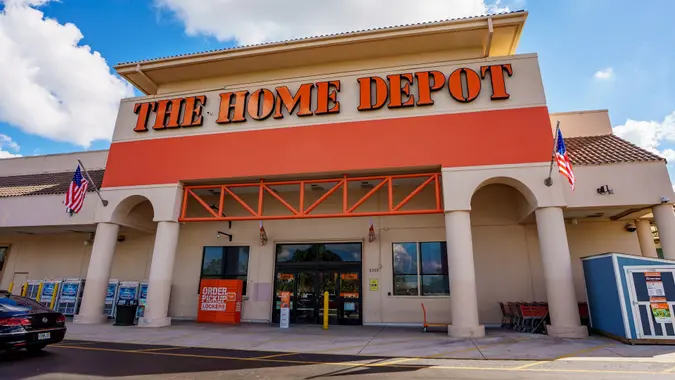Advertiser Disclosure
GOBankingRates works with many financial advertisers to showcase their products and services to our audiences. These brands compensate us to advertise their products in ads across our site. This compensation may impact how and where products appear on this site. We are not a comparison-tool and these offers do not represent all available deposit, investment, loan or credit products.
10 Home Renovations That Save You Money
 Written by
Jennifer Taylor
Written by
Jennifer Taylor
 Edited by
Somnia Keesey
Edited by
Somnia Keesey

Commitment to Our Readers
GOBankingRates' editorial team is committed to bringing you unbiased reviews and information. We use data-driven methodologies to evaluate financial products and services - our reviews and ratings are not influenced by advertisers. You can read more about our editorial guidelines and our products and services review methodology.

20 YearsHelping You Live Richer

Reviewed by Experts

Trusted by Millions of Readers
Your utility bills are putting a major dent in your budget. Chances are, you’re not the only one facing this issue.
As of 2021, U.S. households have an average monthly electric bill of $122, according to the U.S. Energy Information Administration. Additionally, the average residential gas bill in the U.S. is $761 per year, as of 2021, according to the American Gas Association.
Utilities themselves are essential, but there are plenty of home renovations you can make that will allow you to enjoy the comforts of home for less. You might think the cost of purchasing and installing these updates is unattainable, but some are a lot simpler than you may realize.
Whether you’re looking to make major energy-efficient renovations or simply find a few minor updates that will make a difference, there are plenty of options to choose from. Keep reading to discover 10 home renovations that can lower your utility bills.
Programmable Thermostat
If you’re still using a manual thermostat, it could be costing you.
“A programmable thermostat can help you save up to 10% on your home heating and cooling costs — including electricity — if you have an air conditioner, electric furnace, heat pump or mini splits,” said Lane Dixon, vice president of operations at Aire Serv, a Neighborly company. “The beauty of a programmable thermostat is that it allows you to increase energy savings without decreasing comfort.”
Make Your Home Airtight
Help your home maintain a more consistent temperature by sealing the cracks or leaking areas around doors and windows, Dixon advised.
“One of the best ways to reduce energy costs is to always replace your HVAC air filters when they are dirty — around every 90 days,” he said. “If you’re consistent with air filter replacement, your HVAC unit will run more efficiently.”
Taking this step may also help you save on pricey repairs to your big-ticket HVAC appliances down the line, he said.
Energy-Efficient Light Bulbs
Swapping out inefficient light bulbs for efficient options like LED and CFL bulbs can ultimately save you a lot of money, said Joel Worthington, president at Mr. Electric, a Neighborly company.
“Compared to the old incandescent bulbs, CFLs and LEDs use 75-85% less energy and can last 10-25 times longer,” he said. “If you’re tired of constantly changing light bulbs, it might be worth considering investing in this technology to save yourself time and money.”
Dimmer Switches
If you don’t already have dimmer switches in your home, Worthington recommended adding them.
“A dimmer switch decreases the amount of energy running to your lights,” he said. “Dimmers help save on electricity and extend the life of light bulbs.”
In addition to helping you save money, this will also improve the look and feel of the room. You’ll enjoy being able to adjust the lighting to create an atmosphere that’s warm and inviting.
Ceiling Fans
If your home doesn’t already have ceiling fans — or doesn’t have enough — Worthington said installing them can allow you to decrease your energy usage and expenses.
“Instead of relying on air conditioning units, which use a lot of power, ceiling fans use the wind chill effect to cool you down,” he said. “If installed and used correctly, they can even allow you to lower your thermostat by four-to-seven degrees Fahrenheit and save up to 30% on cooling costs.”
Smart Leak Detector
It’s possible you have leaky pipes and don’t even know it — or will in the future. Therefore, Doyle James, president at Mr. Rooter Plumbing, a Neighborly company, recommended using a smart leak detector to spot this issue immediately.
“These devices can be placed under cabinets and by the water heater to detect leaks and allow the homeowner to take quick action to avoid a potential large water loss,” he said. “The devices can be connected to a smart device like a phone, alerting homeowners there is an issue in real time.”
High-Efficiency Fixtures
“Home water usages such as showering, laundry, dishwashers and irrigation needs comprise a large percentage of typical home water use,” James said. “Water use reduction strategies can include simply tracking use and being mindful of water waste that can be avoided.”
He said you can install high-efficiency bathroom and kitchen fixtures with automatic sensors that shut off water flow when not in immediate use.
“Minimizing landscape irrigation and water during cooler times of the day can also help save water consumption,” he said.
High-Efficiency Toilets
Toilets in your home are used many times per day, so James said choosing more efficient models can allow you to save water. He noted that current federal standards for toilets allow them to use 1.6 gallons per flush, which is what you’ll find in traditional non-low-flow toilets.
“Many toilets today are manufactured to have water-saving options at 1.28 gallons per flush,” he said. “They consume less water, helping to save on utility bills.”
Toilets are the main source of water usage in a home, comprising nearly 30% of the average home’s indoor water consumption, according to the Environmental Protection Agency. Older, more inefficient models use up to 6 gallons of water per flush, so if you have one, this could be causing your bill to surge.
High-Efficiency Appliances
“An appliance with the ‘save more’ Energy Star label is more efficient than a standard-labeled one,” said Ron Shimek, president of Mr. Appliance, a Neighborly company.
He said the Consortium for Energy Efficiency has an appliance energy efficiency tier rating, with tiers two through four having greater efficiency than tier one.
“They’re all in the range of Energy Star’s ‘save more’ standards,” he said. “[The] CEE Advanced Tier is the most efficient and matches Energy Star’s ‘most efficient’ standards.”
However, he noted that appliance energy usage can fluctuate.
“For example, it can become less efficient if it’s not regularly maintained,” he said. “It also may not operate efficiently if the electrical system isn’t up to code, so be sure your major appliances are all on dedicated circuits and that you respond quickly if your appliance keeps tripping a circuit breaker.”
Garage Insulation
“Insulating your garage can make your home more sustainable and improve energy efficiency — especially for those who currently use it for additional living space, office space or a home gym,” said Michael Brickner, president of Precision Garage Door Service, a Neighborly company.
He said opting for an insulated garage door is a great way to insulate the space.
“These are more energy-efficient than a standard single-layer door, due to the extra layer of polystyrene or polyurethane insulation between the steel panels of the door,” he said.
More From GOBankingRates
Share This Article:




You May Also Like








I Asked ChatGPT How To Recover From Overdoing Holiday Spending -- Here's What It Said
December 22, 2025
7 min Read



Best Ways To Save Your Money
Make your money work for you
Get the latest news on investing, money, and more with our free newsletter.
By subscribing, you agree to our Terms of Use and Privacy Policy. Unsubscribe at any time.


Thanks!
You're now subscribed to our newsletter.
Check your inbox for more details.



Sending you timely financial stories that you can bank on.
Sign up for our daily newsletter for the latest financial news and trending topics.
For our full Privacy Policy, click here.
Looks like you're using an adblocker
Please disable your adblocker to enjoy the optimal web experience and access the quality content you appreciate from GOBankingRates.
- AdBlock / uBlock / Brave
- Click the ad blocker extension icon to the right of the address bar
- Disable on this site
- Refresh the page
- Firefox / Edge / DuckDuckGo
- Click on the icon to the left of the address bar
- Disable Tracking Protection
- Refresh the page
- Ghostery
- Click the blue ghost icon to the right of the address bar
- Disable Ad-Blocking, Anti-Tracking, and Never-Consent
- Refresh the page







